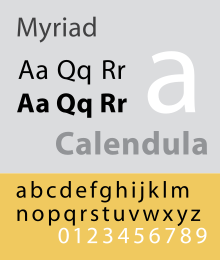Myriad (typeface)
 |
|
| Category | Sans-serif |
|---|---|
| Classification | Humanist |
| Designer(s) |
Robert Slimbach Carol Twombly |
| Foundry | Adobe Type |
| Date released | 1992 |
Myriad is a humanist sans-serif typeface designed by Robert Slimbach and Carol Twombly for Adobe Systems. The typeface is best known for its usage by Apple Inc., replacing Apple Garamond as Apple's corporate font from 2002 to 2017. Myriad is easily distinguished from other sans-serif fonts due to its special "y" descender (tail) and slanting "e" cut. Myriad is similar to Frutiger, although the italic is different; Adrian Frutiger described the font as "not badly done" but felt that the similarities had gone "a little too far". The later Segoe UI and Corbel are also similar.
This PostScript Type 1 font family was released after the original Myriad MM. It initially included four fonts in two weights, with complementary italics. All these Type 1 versions supported the ISO-Adobe character set; all were discontinued in the early 2000s.
Myriad Web is a version of Myriad in TrueType font format, optimized for onscreen use. It supports Adobe CE and Adobe Western 2 character sets. Myriad Web comprises only five fonts: Myriad Web Pro Bold, Myriad Web Pro Regular, Myriad Web Pro Condensed Italic, Myriad Web Pro Condensed, Myriad Web Pro Italic. Myriad Web Pro is slightly wider than Myriad Pro, while the width of Myriad Web Pro Condensed is between Myriad Pro Condensed and Myriad Pro SemiCondensed.
The family is bundled as part of the Adobe Web Type Pro font pack.
Myriad Pro is the OpenType version of the original Myriad font family. It first shipped in 2000, as Adobe moved towards the OpenType standard. Additional designers were Christopher Slye and Fred Brady. Compared to Myriad MM, it added support for Latin Extended, Greek, and Cyrillic characters, as well as oldstyle figures.
Myriad Pro originally included thirty fonts in three widths and five weights each, with complementary italics. A "semi-condensed" width was added in early 2002, expanding the family to forty fonts in four widths and five weights each, with complementary italics.
...
Wikipedia
